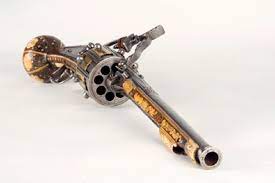History of first Weapons, Gun Timeline Historical timeline of the development of modern weapons starting at 1364 with the first recorded use of a firearm and ending in 1892 with the introduction of automatic handguns.

 1364 – First recorded use of a firearm.
1364 – First recorded use of a firearm.
1380 – Hand guns are known across Europe.
1400s – The matchlock gun appears.
Before the matchlock, guns were fired by holding a burning wick to a “touch hole” in the barrel igniting the powder inside. A shooter uses one hand for firing, and a prop to steady the gun.The first device, or “lock,” for mechanically firing a gun is the matchlock. Powder is held in a “flash pan,” and ignited by a wick, or match, in a movable clamp. Both hands remain on the gun, vastly improving aim. Early matchlock guns are extremely rare. The matchlock shown here was made around 1640, and is typical of the muskets used by militia in Colonial America.
 1498 – Rifling principle is discovered.
1498 – Rifling principle is discovered.
1509 – Invention of wheel lock (rose lock).
The next major advance, the wheel lock, generates a spark mechanically. With no wick to keep lit, the wheel lock is easier to use, and more reliable than the matchlock. However, wheel locks are expensive to produce. Matchlocks, at half the cost, remain in common use. This is an early (ca. 1540) multi-shot, wheel-lock pistol, made for Emperor Charles V. In this weapon, two locks are combined in one mechanism, to give each barrel separate ignition.
 1540 – Rifling appears in firearms.
1540 – Rifling appears in firearms.
1607 – Settlers arrive in Jamestown, Virginia.
1630 – The first true flintlock.
The flintlock solved a longstanding problem. Some time in the late 1500s, a lid was added to the flash pan design. To expose or protect the powder, the lid had to be moved manually. The flintlock mechanism was designed to push back the lid and spark a flint at the same time. The flintlock ignition system reigned for two centuries, with virtually no alteration. The flintlock pictured here is a typical British “Brown Bess” musket. Marks on the gun indicate that it was used by German mercenaries during the American Revolution.
 1637 – First use of firearms proof-marks.
1637 – First use of firearms proof-marks.
1750-1850 – Dueling pistols come into fashion.
Around 1750, men stop carrying rapiers, and guns became the weapon of choice for a duel. Various guns were used, until a true dueling pistol was officially standardized in 1777, as “a 9 or 10 inch barreled, smooth bore flintlock of 1 inch bore, carrying a ball of 48 to the pound.” Often lavishly decorated, the pistols are made until dueling falls out of favor in the mid-1800s. This pair of 1786 flintlock pistols was made with ivory stocks and unusually elaborate decorative details.
 1776 – American Revolution.
1776 – American Revolution.
1807 – Percussion-detonating principle patented.
1825 ca. – Percussion-cap guns are in general use.
1830 – The back action lock appears.
1835 – The first Colt revolver.
Samuel Colt developed the first mass-produced, multi-shot, revolving firearms. Various revolving designs had been around for centuries, but precision parts couldn’t be made with available technologies. Colt was the first to apply Industrial Age machining tools to the idea. Mass production made the guns affordable. Reliability and accuracy made the Colt a favorite of soldiers and frontiersmen. The Colt depicted is a Third Model Dragoon percussion revolver (ca. 1853). A Colt with such lavish decoration and gold inlay is extremely rare.
 1840 – Guns begin to use pin-fire cartridges.
1840 – Guns begin to use pin-fire cartridges.
1847 – The telegraph is invented.
1850 – True shotguns in common use.
In the second half of the 18th century, musket design branched out. This period produced a number of single-purpose firearms. The forerunner of modern shotguns was the fowling piece, developed specifically for hunting birds. Among the upper classes, fowling was a leisure sport. Fowling pieces for the very affluent were often lovely works of art, but impractical for hunting.
 1854-56 – The Crimean War. The last war to use only muzzle-loaded guns.
1854-56 – The Crimean War. The last war to use only muzzle-loaded guns.
1859 – The first full rim-fire cartridge.
1860 – Spencer repeating carbine patented.
Introduced at the start of the Civil War, Spencer repeating guns were technically advanced, used cartridges (a recent development), and could fire 7 shots in 15 seconds. But the Army didn’t want a repeating gun, fearing that soldiers would fire more often, constantly need fresh ammunition, and overtax the supply system. But in 1863, President Lincoln test-fired a Spencer. His approval led to the purchase of 107,372 Spencer repeating carbines and rifles (of 144,500 made), and the Spencer became the principal repeating gun of the Civil War.
 1861 – Breech loaded guns in common use.
1861 – Breech loaded guns in common use.
1861-1865 – American Civil War. Both breech and muzzle loaded guns used.
1862 – The Gatling Gun is invented.
1869 – Center-fire cartridge introduced.
1870-1871- The Franco-German War. Breach-loaded guns are dominant.
1871 – First cartridge revolver.
1873 – Winchester rifle introduced.
Winchester rifles were affordable, and produced in such great numbers, that the Winchester became the generic rifle. The Winchester had such a powerful hold in some regions that it actually became known as “the gun that won the West.” In 1887, Winchester came out with their first repeating shotguns. The next major milestone for Winchester came in 1903, when the company introduced the first automatic rifle that would become widely used.
 1876 – Custer defeated at Little Big Horn.
1876 – Custer defeated at Little Big Horn.
1877 – First effective double-action revolver.
1879 – Lee box magazine patented.
1892- Advent of automatic handguns.
The first automatic pistol was created by Joseph Laumann in 1892. But the Borchardt pistol of 1893 was the first automatic with a separate magazine in the grip, and this remains the defining feature of the breed. More automatics came in rapid succession, including Browning, Luger, Mauser, and Colt models. By the turn of the century, just 8 years after Laumann, automatics were firmly established.
People have used weapons in warfare, hunting, self-defense, law enforcement, and criminal activity. Weapons also serve many other purposes in society including use in sports, collections for display, and historical displays and demonstrations. As technology has developed throughout history, weapons have changed with it. Major innovations in the history of weapons have included the adoption of different materials – from stone and wood to different metals, and modern synthetic materials such as plastics – and the developments of different weapon styles either to fit the terrain or to support or counteract different battlefield tactics and defensive equipment. The use of weapons is a major driver of cultural evolution and human history up to today, since weapons are a type of tool which is used to dominate and subdue autonomous agents such as animals and by that allow for an expansion of the cultural niche, while simultaneously other weapon users (i.e., agents such as humans, groups, cultures) are able to adapt to weapons of enemies by learning, triggering a continuous process of competitive technological, skill and cognitive improvement (arms race).[1]
Prehistory and the ancient world
Stone tips, arrows and bows
Stone tips are one of the earliest forms of weapons assumed by archaeologists, with the earliest surviving examples of stone tips with animal blood dating to around 64,000 years ago from the Natal, in what is now South Africa.[2] These early arrows were just a stone tip, which is advantageous over organic materials because it enables weapons to cut through tougher hides and create larger wounds, killing more easily.[2] There is as yet no direct evidence for bows during the African Pleistocene, and the hypothesis that very early, stone points were used to tip darts or arrows remains unsupported by use-trace studies and contextual evidence. Some hypothesised concomitants, such as the use of bow drills, also remain elusive.[3]
Bows and arrows had arrived in Europe by the Late Paleolithic period, around 9,000–11,000 BCE,[4] and seem to have arrived in the Americas by at least 6,000 BCE.[5]
The oldest extant bows, from the Holmegård region in Denmark, date to around 6,000 BCE. The bows were quite effective against the enemies that were far from the archer, and so archers were sought after in recruitment for armies. When people started horse riding at around 2500 BCE, composite bows were created. In 1200 BCE, the Hittites, originating from Anatolia, shot arrows using their bows on light chariots. In 1000 BCE some of these horse-riding archers from Central Asia invented the recurve bow, which was in the shape of a “W” and had an improved elasticity.
People from the Nile used relatively long bows for better accuracy, they also used composite bows. Civilizations all over the world produced bows according to their respective vegetation. The Chinese made bows from bamboo sticks while others who did not have the right kind of wood needed for making bows, produced composite bows. According to Chinese beliefs and mythology, a story is narrated and written in old Chinese texts which says how bow and arrow were invented.
ONCE upon a time, Huangdi went out hunting armed with a stone knife. Suddenly, a tiger sprang out of the undergrowth, Huangdi shinned up a mulberry tree to escape. Being a patient creature, the tiger sat down at the bottom of the tree to see what would happen next. Huangdi saw that the mulberry wood was supple, so he cut off a branch with his stone knife to make a bow. Then he saw a vine growing on the tree, and he cut a length from it to make a string. Next he saw some bamboo nearby that was straight, so he cut a piece to make an arrow. With his bow and arrow, he shot the tiger in the eye. The tiger ran off and Huangdi made his escape.[6]
As humans discovered new natural resources beneath the Earth’s surface, traditional weapons were replaced as methods for metal-working developed.
After the discovery of pure copper in Anatolia, around 6000 BCE, copper metallurgy spread in Egypt and Mesopotamia. Around 3500 BCE the art of metallurgy spread into India, China and Europe.[7] Bronze, an alloy of copper and tin, ha d been used as far back as 4500 BCE, as it is much harder than pure copper. It was used extensively in Asia: the Indus Valley Civilization flourished as a result of improved metallurgy. Neolithic communities who lived primarily in the upper Yellow River in China also used bronze items extensively as a number of artifacts were recovered at the Majiayao site. Bronze was produced on a large scale in China for weapons, including spears, pole-axes, pole-based dagger-axes, composite bows, and bronze or leather helmets.[8] From the excavations at Zhengzhou, it is evident that the Chinese during the Shang dynasty had well built walls, large buildings, bronze foundries, and bone and pottery workshops.[9]
Bronze significantly contributed to the ancient world and helped cultures of Mesopotamia, Egypt, Greece, Rome, Indus and China flourish. Bronze replaced stone in weapons.[10] During the Bronze Age maces were in high demand. The Sumerians were the first people on record to have used bronze weapons. Native Americans mostly used flint spears and knives but used bronze for ceremonies and intricate decorations. Ancient artisans soon discovered the drawbacks of bronze for producing armaments, as while weapons made of bronze could be sharpened easily, they were not able to hold their edge.[11] Along with maces, bows and arrows and slings were used in wars. Bows and arrows were preferred over spears because they were easy to handle, provided greater mobility, were more accurate and did not require as much raw material.[citation needed] Bows and arrows were a boon for hunters as they could hunt more effectively with a bow and arrow than with a spear, and so the bow enabled ancient man to become the most efficient hunter.






